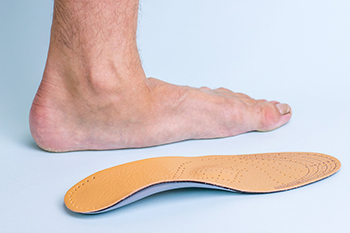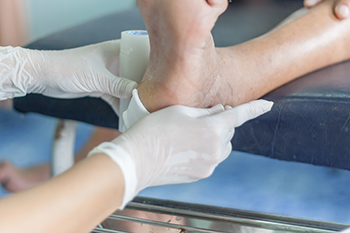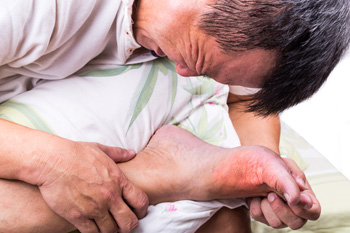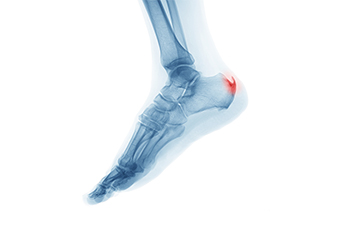(410) 764-7044
6506 Reisterstown Road, Baltimore
1205 York Road, Lutherville
6305 Belair Road, Baltimore
7809 Wise Avenue, Dundalk
November 2022
Flat Feet and Back Pain

As many individuals might already know, a common foot affliction called flat feet is present when a person’s entire foot lays flush against the floor. In other words, the arch of the foot is not discernable and the entire sole, or bottom, of the foot, touches the ground. Flat feet have an interesting connection to back pain that health-conscious people ought to know about. Specifically, having flat feet can increase an individual’s risk of experiencing back pain of some kind. Lower back pain in particular might be especially more likely. One potential explanation for this phenomenon is that flat feet are not able to effectively absorb force and shock. Flat feet also can put stress on other parts of the body, due to the biomechanical misalignment of the feet. Back pain can become more likely. If you have questions about flat feet and back pain, contact a podiatrist today.
Flatfoot is a condition many people suffer from. If you have flat feet, contact one of our podiatrists from Plaza Podiatry. Our doctors will treat your foot and ankle needs.
What Are Flat Feet?
Flatfoot is a condition in which the arch of the foot is depressed and the sole of the foot is almost completely in contact with the ground. About 20-30% of the population generally has flat feet because their arches never formed during growth.
Conditions & Problems:
Having flat feet makes it difficult to run or walk because of the stress placed on the ankles.
Alignment – The general alignment of your legs can be disrupted, because the ankles move inward which can cause major discomfort.
Knees – If you have complications with your knees, flat feet can be a contributor to arthritis in that area.
Symptoms
- Pain around the heel or arch area
- Trouble standing on the tip toe
- Swelling around the inside of the ankle
- Flat look to one or both feet
- Having your shoes feel uneven when worn
Treatment
If you are experiencing pain and stress on the foot you may weaken the posterior tibial tendon, which runs around the inside of the ankle.
If you have any questions please feel free to contact our offices located in Baltimore, Lutherville, and Dundalk, MD . We offer the newest diagnostic and treatment technologies for all your foot and ankle needs.
Causes and Treatment of Sever’s Disease

In the first few years of a child’s life, the bones in their feet develop from soft areas of cartilage, known as growth plates. Once the growth plate fully develops, the bones do not grow any further. The heel bone grows until about the age of 15. A child between the ages of 9 and 15 who is physically active may develop a condition known as Sever’s disease. This is simply an imbalance between the growth of the heel bone and the soft tissue. The result is pain around the heel, which is made worse by running or standing on tiptoes. It is nearly impossible to detect Sever’s disease from an X-ray, but the symptoms usually are enough to make an accurate diagnosis. Relief from Sever’s disease comes from ceasing the activity that caused it and resting the foot. Heel pads and splinting at night can help to reduce the pain. For more information about Sever’s disease, please check with a podiatrist.
Sever's disease often occurs in children and teens. If your child is experiencing foot or ankle pain, see one of our podiatrists from Plaza Podiatry. Our doctors can treat your child’s foot and ankle needs.
Sever’s Disease
Sever’s disease is also known as calcaneal apophysitis, which is a medical condition that causes heel pain I none or both feet. The disease is known to affect children between the ages of 8 and 14.
Sever’s disease occurs when part of the child’s heel known as the growth plate (calcaneal epiphysis) is attached to the Achilles tendon. This area can suffer injury when the muscles and tendons of the growing foot do not keep pace with bone growth. Therefore, the constant pain which one experiences at the back of the heel will make the child unable to put any weight on the heel. The child is then forced to walk on their toes.
Symptoms
Acute pain – Pain associated with Sever’s disease is usually felt in the heel when the child engages in physical activity such as walking, jumping and or running.
Highly active – Children who are very active are among the most susceptible in experiencing Sever’s disease, because of the stress and tension placed on their feet.
If you have any questions, please feel free to contact our offices located in Baltimore, Lutherville, and Dundalk, MD . We offer the newest diagnostic and treatment technologies for all your foot and ankle injuries.
Minor and Major Foot Wounds

An open wound on the foot can be painful. It is defined as a break or cut in the skin, and in most cases, is found on the surface of the skin. More serious wounds affect the deeper tissues of the foot, and this can spread to the tendons, muscles, and nerves. Minor cuts are often treated by cleaning the wound, followed by covering it with a protective bandage. Stitches may be necessary to accelerate the healing process, in addition to possibly using an adhesive glue. For more serious wounds, medical attention is often sought for relief. The wound may become dirty, and this is the term that is used when germs have entered the wound. This can lead to a possible infection, and recovery instructions must be strictly followed to prevent scarring. If you have a wound on your foot, it is urgently suggested that you are under the care of a podiatrist who can provide the best treatment for the type of foot wound you have.
Wound care is an important part in dealing with diabetes. If you have diabetes and a foot wound or would like more information about wound care for diabetics, consult with one of our podiatrists from Plaza Podiatry. Our doctors will assess your condition and provide you with quality foot and ankle treatment.
What Is Wound Care?
Wound care is the practice of taking proper care of a wound. This can range from the smallest to the largest of wounds. While everyone can benefit from proper wound care, it is much more important for diabetics. Diabetics often suffer from poor blood circulation which causes wounds to heal much slower than they would in a non-diabetic.
What Is the Importance of Wound Care?
While it may not seem apparent with small ulcers on the foot, for diabetics, any size ulcer can become infected. Diabetics often also suffer from neuropathy, or nerve loss. This means they might not even feel when they have an ulcer on their foot. If the wound becomes severely infected, amputation may be necessary. Therefore, it is of the upmost importance to properly care for any and all foot wounds.
How to Care for Wounds
The best way to care for foot wounds is to prevent them. For diabetics, this means daily inspections of the feet for any signs of abnormalities or ulcers. It is also recommended to see a podiatrist several times a year for a foot inspection. If you do have an ulcer, run the wound under water to clear dirt from the wound; then apply antibiotic ointment to the wound and cover with a bandage. Bandages should be changed daily and keeping pressure off the wound is smart. It is advised to see a podiatrist, who can keep an eye on it.
If you have any questions, please feel free to contact our offices located in Baltimore, Lutherville, and Dundalk, MD . We offer the newest diagnostic and treatment technologies for all your foot care needs.
Arthritis Can Cause Pain in the Feet and Ankles
Causes and Risks of Gout

Gout is a form of arthritis that results in joint pain and swelling in the joints and frequently attacks the big toe. Gout is caused by a buildup of uric acid in the blood that forms crystals in the joints. If ignored, gout can result in serious health issues affecting the kidneys and may permanently damage the joints. The main cause of high uric acid in the blood is that it is not being flushed out properly. Genetics is thought to be the number one contributor to this. Other factors include underlying health issues and side effects of certain medication. You may be at higher risk of developing gout if you are overweight, have high blood pressure, and eat foods rich in purines. Men over 40 and women in menopause are also at greater risk of developing gout. If you have two or more gout attacks in your toe within a year, it is a good idea to contact a podiatrist. A number of medical treatments are available to keep the uric acid levels down. Changes to diet and weight reduction may also be recommended.
Gout is a foot condition that requires certain treatment and care. If you are seeking treatment, contact one of our podiatrists from Plaza Podiatry. Our doctors will treat your foot and ankle needs.
What Is Gout?
Gout is a type of arthritis caused by a buildup of uric acid in the bloodstream. It often develops in the foot, especially the big toe area, although it can manifest in other parts of the body as well. Gout can make walking and standing very painful and is especially common in diabetics and the obese.
People typically get gout because of a poor diet. Genetic predisposition is also a factor. The children of parents who have had gout frequently have a chance of developing it themselves.
Gout can easily be identified by redness and inflammation of the big toe and the surrounding areas of the foot. Other symptoms include extreme fatigue, joint pain, and running high fevers. Sometimes corticosteroid drugs can be prescribed to treat gout, but the best way to combat this disease is to get more exercise and eat a better diet.
If you have any questions please feel free to contact our offices located in Baltimore, Lutherville, and Dundalk, MD . We offer the newest diagnostic and treatment technologies for all your foot and ankle needs.
Causes and Relief Tactics for Heel Spurs

Despite how small a heel spur can be, it is capable of causing severe pain and discomfort. It is defined as a bony protrusion that forms on the bottom of the heel, and can occur due to a heel injury. Additionally, it may occur from overuse while running, and this can cause the heel bone to undergo chronic stress. To compensate for this, the body’s natural defenses will form a bone that protrudes from the heel for protection. Many patients who have heel spurs experience little or no pain, and there are some people who have severe discomfort from a heel spur. This may be a result of an underlying condition that can affect the sole of the foot. An X-ray is often performed that can provide an accurate diagnosis, which can help to determine the severity of the heel spur. Mild relief may be found when lifestyle changes are implemented. These can include losing additional weight, wearing shoes that can accommodate the heel spur and are comfortable, and it may help to limit athletic activities. Surgery may be necessary for permanent relief. If you have developed a heel spur, please confer with a podiatrist who can help you to decide which treatment method is best for you.
Heel spurs can be incredibly painful and sometimes may make you unable to participate in physical activities. To get medical care for your heel spurs, contact one of our podiatrists from Plaza Podiatry. Our doctors will do everything possible to treat your condition.
Heels Spurs
Heel spurs are formed by calcium deposits on the back of the foot where the heel is. This can also be caused by small fragments of bone breaking off one section of the foot, attaching onto the back of the foot. Heel spurs can also be bone growth on the back of the foot and may grow in the direction of the arch of the foot.
Older individuals usually suffer from heel spurs and pain sometimes intensifies with age. One of the main condition's spurs are related to is plantar fasciitis.
Pain
The pain associated with spurs is often because of weight placed on the feet. When someone is walking, their entire weight is concentrated on the feet. Bone spurs then have the tendency to affect other bones and tissues around the foot. As the pain continues, the feet will become tender and sensitive over time.
Treatments
There are many ways to treat heel spurs. If one is suffering from heel spurs in conjunction with pain, there are several methods for healing. Medication, surgery, and herbal care are some options.
If you have any questions feel free to contact our offices located in Baltimore, Lutherville, and Dundalk, MD . We offer the latest in diagnostic and treatment technology to meet your needs.





